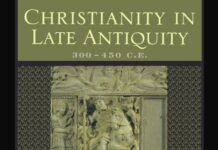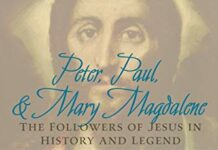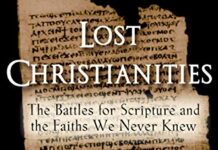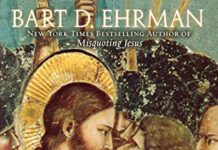
Ebook Info
- Published: 2009
- Number of pages: 288 pages
- Format: PDF
- File Size: 0.00 MB
- Authors: Bart D. Ehrman
Description
When world-class biblical scholar Bart Ehrman first began to study the texts of the Bible in their original languages he was startled to discover the multitude of mistakes and intentional alterations that had been made by earlier translators. In Misquoting Jesus, Ehrman tells the story behind the mistakes and changes that ancient scribes made to the New Testament and shows the great impact they had upon the Bible we use today. He frames his account with personal reflections on how his study of the Greek manuscripts made him abandon his once ultraconservative views of the Bible.Since the advent of the printing press and the accurate reproduction of texts, most people have assumed that when they read the New Testament they are reading an exact copy of Jesus’s words or Saint Paul’s writings. And yet, for almost fifteen hundred years these manuscripts were hand copied by scribes who were deeply influenced by the cultural, theological, and political disputes of their day. Both mistakes and intentional changes abound in the surviving manuscripts, making the original words difficult to reconstruct. For the first time, Ehrman reveals where and why these changes were made and how scholars go about reconstructing the original words of the New Testament as closely as possible.Ehrman makes the provocative case that many of our cherished biblical stories and widely held beliefs concerning the divinity of Jesus, the Trinity, and the divine origins of the Bible itself stem from both intentional and accidental alterations by scribes — alterations that dramatically affected all subsequent versions of the Bible.
User’s Reviews
Reviews from Amazon users which were colected at the time this book was published on the website:
⭐A well written book about the evolution of the Bible, particularly the New Testament, and how our present text came to be in all its various forms. Dr. Ehrman begins with a brief summary of his own life. From an “ordinary kid” he becomes a fundamentalist Christian believing the Bible to be wholly inspired. During his graduate program in a Christian school he develops an interest in the wide variety of historical documents that have, through many generations come down to us a our present Bible. He becomes, in short, a textual-scholar, and has an epiphany!Ehrman quickly learns that there are no longer any “original texts” anywhere. The earliest texts found, more fragmented the farther back one goes, come from the 2nd century some 100 years after Jesus’ death. None of the original Apostles, nor Paul are any longer alive at that point, and what early notes exist for geographically fragmented communities are already copies of lost originals. Even if the literal-original writing was “inspired by God” as fundamentalists claim, by the opening of the 2nd century the earliest copies of these writings have already passed through human hands and the real originals are no more. Except for the Christian community of Alexandria where professional scribes already existed, all of the early copies were made by amateur believers who, as it happened could read and write, and so copied texts for their congregations; sometimes well and sometimes poorly. It was not until late in the 4th century that more professional scribes assumed the copyist role.Roughly the first half of the book is taken up with the history of textual criticism. Ehrman leads us through early (17th century) classification attempts and the techniques developed to determine which texts were “more original” than others. Ehrman notes that in many many cases even that matter cannot be decided with any finality. That the modern obsession with the text began after the Reformation is no accident. Protestant scholars were far more compulsive about the text than Catholics. Protestant theology and doctrine rests entirely on the text, while Catholicism has its priestly class for precisely the task of interpreting the text in what ever form it takes. By the 18th century, scholars had identified some 30,000 textual variations in the manuscripts that come together as the then relatively stabilized New Testament.Most of these variations were simply mistakes made by non-professional copyists. Sometimes they left out a word or whole sentences. Sometimes what there were of literal originals were physically degraded even when first copied. Copyists sometimes had to “fill in the blanks”, a smudged word, or a bleed-through from some earlier text on the page for example. So why not go back to the more professional Alexandrian texts and call those “closest to original”? Because while the vast majority of changes were copy errors, not all were merely that. Here and there changes were made for theological and socio-political reasons. In point of fact (something he does not mention) the Alexandrian scholars were among those who, by the early 5th Century, were considered among the heretical sects by the then solidifying Roman Church. Ehrman does not mention is the textual difference between the modern Western (Roman) and Eastern (Greek and Eastern European “Orthodox”) churches. His aim is historical, and he does cover the early Greek texts whose alterations became mixed in with all of the others.In the second half of the book Ehrman covers three types of changes made deliberately by one group of copyists or another so as to make the text easier to read and better line up with the various theological opinions and social controversies of the time, each propounded by groups of believers who were doing their own copying! In the end, Ehrman is forced to conclude that even the lost originals were probably not autodidacts (texts dictated by God) because if God had wanted Christians to have his un-corrupted words in perpetuity, He would have made sure the originals survived.I gave the book 5 stars not because the book’s subject was of great interest to me, but because Dr. Ehrman does such a marvelous job of treating a scholarly subject (many many references are provided) with easy to read language aimed at non-scholars of the subject like myself.
⭐Ehrman argues for two theses, one practical and one more abstract.The practical thesis can be summarized as: We do not possess any of the original writings of the New Testament, and the copies we have are riddled with negligent and/or intentional alterations. Therefore, the New Testament we read today, which is based upon numerous altered copies, is not very close to the original text. And if the original text is the Word of God, the Word of God is lost.The abstract thesis can be summarized as: For any text, both the author’s and the reader’s subjective beliefs and experiences condition the meaning of the words, and therefore color the interpretation of the text. As a result, there is no such thing as an objectively true interpretation of a text. The search for the “correct” meaning is fruitless. Therefore, no one can claim to know the true meaning of the text of the New Testament.The upshot? The New Testament we read today is of human, and not divine, origin (practical thesis), and, in any event, any claim to “the One True Interpretation” is in principle false (abstract thesis).I will not take a stand on Ehrman’s claims but hope I’ve faithfully outlined them for people deciding whether to purchase the book. I am familiar with but not well-versed in either the New Testament or textual criticism. Nonetheless, I found his arguments and analysis easy to track. The broad historical information was interesting, and the biblical passages he focuses on to illustrate his points are engaging instead of arcane. Some may consider this book anti-religious, but Ehrman’s tone is respectful and honest, not polemical. For such a short, accessible book, the reader can gain a lot from reading it.
⭐I enjoyed reading this book very much. As the author Bart Ehrman gave a brief introduction of his early life in how he became a “born-again” believer of Jesus Christ in his teens. To how he was told and believed that the Holy Bible is the inerrant word of God… Until he went to Bible College, learned Greek and began to see many changes in the present English translations from some of the earlier copies of the Greek manuscripts. Ehrman became a textual critic of the New Testament.In this book, Ehrman tells a compelling and convincing reason to not believe that the Bible is the “infallible word of God” – In explaining that we don’t have the original manuscripts. What is available are “copies of copies of copies”. Another thing that is pointed out was in the 1st century church, 90 percent of the people were illiterate. That the scribes available to copy the Gospels and Paul’s letters that circulated around for the first few centuries were not professional scribes – nor are any of those copies available today, they have not survived.Ehrman points out that in the first few centuries, there were many different ideas floating around about who Jesus was and many different sects of beliefs; some followers of Christ believed Jesus was fully human others believed he was fully God. There were other people who wrote Gospels and letters however did not get canonized into the present Bible at the time of the Council of Nicea in the 4th century. When Roman emperor Constantine had a conversion into Christianity in 325 A.D. and decided to choose which Gospels and letters to formulate the Bible. And today we don’t even have those copies available to decipher.Bart Ehrman is not the first textual critic of the New Testement and explains the history of textual criticism dating to the 18th century and even then – 30,000 errors were uncovered from the English Bible from the earliest surviving manuscripts. An example of these errors is how things have been added into the Bible, in other words they are not in the early manuscripts; i.e. when Jesus said “forgive them father for they know not what they do.” that wasn’t in the early manuscripts. Or how Jesus said “he who is without sin, cast the first stone” – that too was not in the early manuscripts.Another interesting thing Ehrman uncovers is that the surviving manuscripts of Revelations, the apocalyptic book of the Bible – is that those manuscripts are illegible and did not have the last three chapters. So the scripture in the end of Revelations that states Jesus is coming back; “a rider on a white horse, with fire in his eyes, and a sword out of his mouth.” —- that was made up!I too used to believe that the Bible was the infallible word of God when I too became a “born again” believer in my early teens as Ehrman. I began to question the idea of eternal hell and found (from other Bible scholars) that the early manuscripts did not have the idea of hell and eternity put together. Instead of the word hell, the words that Jesus supposedly spoke were “Gehenna” an actual valley in Jerusalem or “Sheol” which means “the grave” – and “Aionion” instead of eternity, which means “a long time or age of the ages” – not forever…. (You can actually learn that Jesus was not speaking of hell and eternity if you read the oldest Gospel which is Mark as Ehrman states, and read the Lamsa translation from the Aramaic Peshitta – eternal hell is not in the book of Mark in the Lamsa Bible.)It has been very liberating reading this book, I thank Bart Ehrman for putting in the great effort to become just about the top bible scholar of the New Testament. Though I still believe in Jesus Christ as a Savior and an Avatar – I now question some of the contradictions in the Gospels – It remains a mystery to what Jesus actually said – I can no longer look at the Bible the same.
⭐For a non-christian absolutely fascinated with the Bible, the lasting resonance it has imbued mankind with is a constant source of great interest to me.I’ve never truly understood how it came to be, and why it seems to be a confused collection of separate works, as opposed to a clear dictation from the all mighty. This book not only explains the origins, but it also does so with clarity and ease, and that’s greatly appreciated.Let me say this was an excellent book. The author it seems is a brilliant teacher. Clear explanations and written in a style that is vivid and engaging especially for what could be a slightly dour and dusty subject if you’re not specifically into the history of the biblical text. Which I’m not really in any meaning full way.My mind is dancing with curiosity even more so after reading. Yes, this book clearly demonstrates the Bible isn’t divinely inspired as such, with so many glaring sometimes embarrassing examples of openly human intervention. But it’s more than just those examples or errors alone for me.I now want to know more, the original traditions that the first authors used to craft this most important of books, where did they come from? More questions, I want to dive deeper, which is a good thing as the author has written several books on this, and i now crave more!Bart D Ehrman has found a new fan in me, this being the first book of his I’ve read. I will already be deep into the next one following on from this, probably finished it, by the time you read this.Misquoting Jesus is essential reading for Christians and anyone outside of that with evem a slight interest in religion. It’s great.
⭐This is a very interesting and well written book, that examines how the manuscripts of the New Testament have been altered and adapted over time. The author, a biblical scholar, examines the historical process which has changed the New Testament. The original manuscripts – written during the latter part of the 1st century and the first part of the second century, no longer exist … nor do the first copies that were made during the second 2nd century. Nor, indeed, do the initial copies of the copies – as made during the 3rd century. What we have access to are copies of the copies of the copies of the copies … And the earliest such documents that still survive are from the 4th century. These manuscripts, written centuries after the originals, contain many differences. As such, we simply don’t possess – and can’t access – the originals. And what we do possess clearly show that many changes have been made.Given that so many changes were made during the initial centuries following the writing of the original New Testament manuscripts, we can’t know what those originals actually said. All we know is what later writers offer us … and, as these later documents are so very different from each other, we’ve no idea which – if any – is more authentic. What’s more, still later versions of the New Testament – such as the King James – are is various ways different from the earliest existing manuscripts. So further changes – throughout the second half of the first millennium, and during the first half of the second millennium – have been made. Sentences in the text have been altered; new sentences have been added!What Ehrman does is provide us with a fascinating account on who changed the New Testament. This is a book written with a popular audience in mind, and it’s straightforward to understand. I found it an enjoyable read … But it is rather short (at some 218 pages), and it goes into little detail as regards what the alterations and changes actually are. Ehrman points out that such adaptations have been made, but says too little about their specifics. I would have enjoyed a more in-depth study. Fortunately, the author has written such a book –
⭐The Orthodox Corruption of Scripture: The Effect of Early Christological Controversies on the Text of the New Testament
⭐.
⭐“Blessed are the cheesemakers” is not what Jesus said in the Sermon on the Mount. It is a line made famous by the Monty Python film “Life of Brian” (1979) which goes to prove that the misquoting of Jesus is a well-known phenomenon. Indeed, it is well worth noting the next line in the movie which was something along the lines of “I think he means purveyors of all dairy products…” In essence Bart D. Ehrman’s 2005 work is a 266-page expansion upon exactly this comedy moment. Regardless of what we find in Matthew 5 we have no idea what Jesus may have really said in this famous sermon. It may have only been written down a long time later and then copied and copied and copied over and over again to the point that our ‘modern’ interpretation might as well be about dairy produce. We are all familiar with the children’s game of ‘Chinese whispers’ so nothing here should be of any surprise. What is key here is whether the misquoting made any fundamental changes to the very nature of Christianity.Certainly, Ehrman comes up with a fair few examples yet a large part of this book describes his own academic career then the academic study of scripture. You have to wade a long way in before you get to examples that really get you thinking. This edition of the book comes with an interview with the author and other bonus items right at the back. The very last item lists the “top ten verses that were not originally in the New Testament”. The second is the well-known phrase that colloquially we remember as “Let he who is without sin cast the first stone…” (John 8:7). This comes as a bit of a blow for those of us who choose to use this in regular conversation. Ehrman chooses not to discuss how the New Testament was compiled nor does he say much about translation errors. Instead, he focusses on changes that were deliberately made through interpretation. The endless rewriting of the Bible tracks the consequences of how the Christian faith evolved into the monolithic religion it is today. It used to be fractured into may diverse interpretations and was endless attacked by Jews and pagans alike. Ehrman urges the reader not to read too much into this because there is less variation in the rewriting of the Gospels over the last 2000 years than there is BETWEEN the gospels themselves. Since Matthew, Mark, Luke and John do not agree on what Jesus was, nor what sort of man he was, then what hope the scribes following up hundreds of years later? The Bible was a random article-of-faith-generator from inception. It was all things to all men, then and always. Was Jesus an angry or compassionate man? Was he distraught or stoic at the thoughts of his crucifixion? Our very image of Jesus is far, far from certain. This is certainly a challenge to any deeply held belief.Ehrman’s conclusion is worth studying in depth. He writes “For the only reason for God to inspire the Bible would be so that his people would have his actual words; but if he really wanted people to have his actual words, surely he would have miraculously preserved those words, just as he had miraculously inspired them in the first place. Given the circumstance that he didn’t preserve the words, the conclusion seemed inescapable to me that he hadn’t gone to the trouble of inspiring them.” A fair point and a devastating one. For the most part this books seems to not challenge any fundamental beliefs. It tinkers around the edge of belief in discussing such things as the role of women in the church or the nature of the early church’s opponents. Yet to think that Ehrman is not fundamentally challenging the very nature of Christian belief is a mistake. He is, but it is beautifully understated. A book to ponder on for a long time.
⭐Bart Ehrman has a consistent and convincing position on the reality of Jesus and the New Testament. Having read several of his books, it boils down to the story of a first century messianic preacher who was elevated to godhood in the generations that followed his death. In “How Jesus Became God”, Ehrman examines that process and the external religious influences that spurred it on. In “Forged”, he looks at how large parts of the New Testament were fraudulently attributed to Paul in particular to support the emerging orthodox Christian position against rival Christian views like Marcionism and Gnosticism. With “Misquoting Jesus”, he’s in the same territory but this time taking a closer look at the role of scribes and translators in accidentally and intentionally altering texts. This book spans a much longer time period from the Romans to the Enlightenment.I think it’s fair to say it complements his other works but if you were starting out on the works of Bart Ehrman, I’d try some of his other writings first – particularly the recent “How Jesus Became God”. Ehrman is much heavier going than Reza Aslan (“Zealot”), but ultimately more rewarding. He may lack Aslan’s fast paced story telling ability, but the analysis is more rewarding and deeper. That’s not to diminish Aslan who has clearly gone for a more populist approach.What Ehrman forces Christians to face up to is a combination of amateur, blundering scribes in the first centuries, deliberate alterations and “improvements” to the texts and a total absence of copyright law in the ancient world. Thousands of changes have wormed their way into the New Testament including accounts of Jesus’s life and works that were inserted into the gospels from other sources. Theological agendas have removed offending words from the original texts and mistranslations have been repeated and accepted.A fascinating book.
⭐Good overview and introduction to the subject, I am some what versed in the region and exeptected it to be more scholarly and more about the ancient feather then modern manuscript editions which I did learn from but wouldn’t be strikingly new information. The quality of the publishing was good and amazon was great in delivery that I give 5 stars. The book as a whole could be more scholarly but Erhman intended this for people not so knowledgeable so as an introduction I’d give 4 to myself it wasn’t the best matirial.
Keywords
Free Download Misquoting Jesus: The Story Behind Who Changed the Bible and Why in PDF format
Misquoting Jesus: The Story Behind Who Changed the Bible and Why PDF Free Download
Download Misquoting Jesus: The Story Behind Who Changed the Bible and Why 2009 PDF Free
Misquoting Jesus: The Story Behind Who Changed the Bible and Why 2009 PDF Free Download
Download Misquoting Jesus: The Story Behind Who Changed the Bible and Why PDF
Free Download Ebook Misquoting Jesus: The Story Behind Who Changed the Bible and Why





